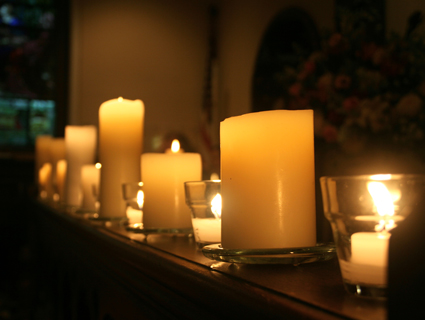
St. George’s pattern of 3 services in the morning gave way to a new church service in 2008, the Celtic service.
The Vestry minutes of Nov., 2007 mentioned that a group was going to visiting St. Stephens in Richmond which had a Celtic Evensong at 5:30pm. “This is part of the process of investigating alternative services. Jim (The Rev. Jim Dannals) is considering a new Sunday night service from the first Sunday in Lent on February 10, 2008 through May.” Alternate forms of worship were being conducted in England and other places looking to attract the unchurched and others. Jim was also encouraged to visit the Celtic service from an old friend Rev. Tom Smith who told him you have got to experience their Celtic service. The Rev. Gary Jones, the rector, had established a Celtic service serving a Memphis church.
Jim described the background of the Celtic in 2016: “The Parish Profile that led to my call to St. George’s clearly stated a desire for another expression of worship and worship music. Thus, by design, after my arrival in December 2004, we began to make plans to add (and not take away) a new expression. Thus, in September 2005, the 8am Rite I moved to 7:45, the 10:30 Rite II moved to 11:00 and we added the 9:00 which we called Rite III. Under John’s leadership, the Jazz component of of the 9am liturgy happened because of the musicians drawn to that service and John’s encouragement and leadership.
“Then, .. in 2007, we responded to what felt like an unmet need for yet another expression of and time for worship. We experimented in the summer of 2007 with a Saturday evening “contemporary” service which gained no traction, but we continued to explore other possibilities for an evening liturgy on Saturday or Sunday that would offer another expression of liturgy and music. We saw this as an opportunity to reach people who were/are spiritually hungry but perhaps not drawn to what was offered in the morning or wanted to worship in the evening
“I was blessed to have an immersion experience in Celtic spirituality in Wales when on Sabbatical in 1995. A very good friend, a retired priest, told me about the Sunday evening Celtic service at St. Stephen’s in Richmond. Carolyn and I went a couple times to experience it, found it life-giving, and decided to invite a group of St. George’s folks to experience it also. ”
“The response was positive and so we decided to offer our own version of “Celtic Evensong + Communion” as an experiment. We purposefully started in Lent and committed to go through at least the end of May. Then we decided to continue through the summer and then we decided to try it as “permanent.”
Celtic spirtuality was already defined. St. Stephens was the model and prayers and readings were borrowed from them. They write about their service – “Our Celtic worship is drawn from the liturgical traditions of Iona and Northumbria, and the music at these services is contemplative, lively and haunting. The prayers are at once earthy, holy and inclusive.”
St. George’s service carried on traditional elements such as a Eucharist and an order of worship. However, many different sources of readings were used from poems, alternative prayer books such as the New Zealand Prayerbook and different Eucharistic prayers. The service was less structured with a sermon that was more of a reflection. The church was bathed with candle light. Music was not the traditional organ but softer piano, guitar, flute and voice. It fit the pace of life at 5:30pm as the day was winding down and the light dimming.
Dannals continues “We immediately realized that the contemplative nature (including the silence) of this liturgy was a big draw, as was Celtic/Appalachian music and the darkness of the space.” They also offered healing prayer from the beginning.
One challenge was timing in relationship to the renovation. When the Celtic began in 2008, the upstairs have was closed in Jan., 2008 until April, 2009. The services moved downstairs to Sydnor Hall. The diamond pane clear glass in that room would make the service too bright. Jan and Tom Meredith came to the rescue and contributed the blinds so that the space could be darkened for the candlelight liturgy.
The service has attracted future new members as well as those from other churches who liked to experience an alternative service. It became its own community and did draw people from the earlier services to become part of that community.
There was an unintended consequence. The Celtic service led to a restriction of the youth into 3rd floor of McGuire instead of using Sydnor Hall. The youth had been planning to relocate back to the Sydnor Hall at the end of renovation in 2009. However, the sound from Sydnor Hall would interfere with the Celtic service occurring in the Nave after construction. The youth were relegated to the 3rd floor of Sydnor. The floor was not only smaller but was it had several classrooms with no open hall.
It was this point in May, 2008 that a proposal was made to take down the walls of 3rd floor McGuire to give them their “own space” as Gay Rahn stated. The archives room did become a kitchen but it would take until the summer of 2016 for the 3rd floor McGuire to give the youth an enlarged space without walls. That was made possible by funds from the Charles Rowe Estate.
